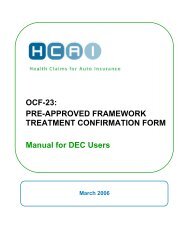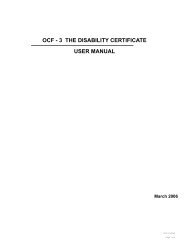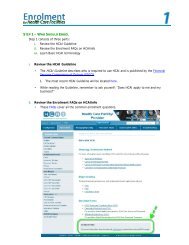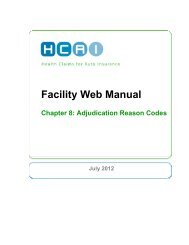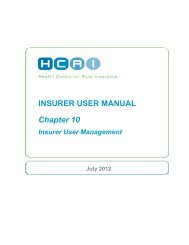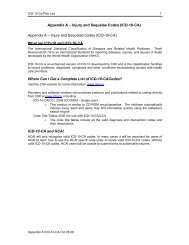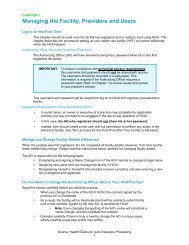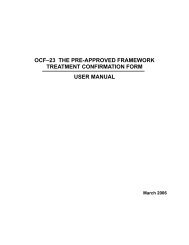OCF-18: TREATMENT & ASSESSMENT PLAN - Manual for ... - HCAI
OCF-18: TREATMENT & ASSESSMENT PLAN - Manual for ... - HCAI
OCF-18: TREATMENT & ASSESSMENT PLAN - Manual for ... - HCAI
You also want an ePaper? Increase the reach of your titles
YUMPU automatically turns print PDFs into web optimized ePapers that Google loves.
IMPORTANT:<br />
The descriptions that will appear under “Description” are defined by the ICD10-Ca<br />
code that is selected.<br />
You may leave the description field empty. When the DEC enters the code, the<br />
description will automatically be populated.<br />
It is not possible to change the description associated with a code.<br />
It is not possible to add text to the standard description.<br />
If you type in<strong>for</strong>mation in the description section which is different from the<br />
standard code description, the insurer will NOT receive that in<strong>for</strong>mation.<br />
To convey details to the insurer, use the narrative text box located in Part 12 (up to<br />
500 characters) or use additional pages (20,000 characters) at the end of the <strong>for</strong>m.<br />
• This section asks the HCF to describe the injuries sustained in the automobile collision, or the<br />
circumstances or problems related to the automobile collision that are responsible <strong>for</strong> the services<br />
being proposed in the plan.<br />
o Example of an injury code:<br />
• S42.0 – Fracture of clavicle<br />
• S43.0 – Dislocation of shoulder joint<br />
o Example of a circumstance code:<br />
• Z58 – Problems related to physical environment<br />
• Z59.1 – Problems related to housing<br />
• Injuries/problems are described using standard codes called the International Classification of<br />
Disease, 10 th version, Canadian edition (ICD-10-Ca)<br />
o ICD-10-CA codes may reflect a diagnosis, condition, problem or circumstance that is<br />
responsible <strong>for</strong> the services being proposed.<br />
o ICD-10-CA codes are not profession-specific.<br />
o Use of ICD-10-CA codes is intended to convey problems and is not necessarily the<br />
equivalent of communicating a diagnosis.<br />
• A partial pick list of commonly used injury codes are available at www.hcaiinfo.ca<br />
• Many health professional associations have developed profession-specific problem code lists.<br />
Contact your health professional association and request, if desired.<br />
Questions about coding?<br />
Visit www.hcaiinfo.ca <strong>for</strong> resources pertaining to coding. If you are unable to locate the in<strong>for</strong>mation you<br />
require, contact your health professional association or organization.<br />
Coding Tips:<br />
• Each code should only be listed once, regardless of how many health professionals will be engaged<br />
in treatment.<br />
• Main Problem:<br />
o The first line item should reflect the problem that is most responsible <strong>for</strong> the services on<br />
the plan. In other words it should reflect the primary reason you are proposing services.<br />
o Example<br />
• If psychological services are required after a brain injury, the first code listed<br />
should reflect the reason that psychology services are being proposed.<br />
E.g., F07.2 – Postconcussional Syndrome.<br />
o In a case where multiple injuries may be classified, put the injury requiring the most<br />
services first.<br />
• Other Problems<br />
o Resolved Injuries<br />
4





